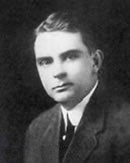Walter Dandy
American neurosurgeon
Walter Edward Dandy (April 6, 1886 – April 19, 1946) was a pioneering American neurosurgeon and one of the founding figures of neurosurgery. He made significant contributions to the understanding and treatment of hydrocephalus, aneurysms, and brain tumors.
Early life and education[edit | edit source]
Walter Dandy was born in Sedalia, Missouri, and he attended the University of Missouri for his undergraduate studies. He later attended the Johns Hopkins School of Medicine, where he completed his medical degree in 1910. During his time at Johns Hopkins, Dandy worked under the mentorship of Harvey Cushing, a prominent figure in neurosurgery.
Career[edit | edit source]
Dandy joined the staff at Johns Hopkins Hospital and quickly became known for his innovative techniques in neurosurgery. He was instrumental in developing new surgical approaches and treatments for various neurological conditions.
Contributions to neurosurgery[edit | edit source]
Dandy is perhaps best known for his work on hydrocephalus, a condition characterized by an accumulation of cerebrospinal fluid in the brain. He developed the technique of ventriculography, which involves injecting air into the ventricular system of the brain to improve the visualization of brain structures on X-rays. This technique was a precursor to modern neuroimaging methods.
Dandy also made significant advances in the treatment of cerebral aneurysms. He was the first to successfully clip an intracranial aneurysm, a procedure that has become a standard treatment for this condition. His work laid the foundation for modern microsurgical techniques used in aneurysm repair.
Brain tumor surgery[edit | edit source]
Dandy was a pioneer in the surgical treatment of brain tumors. He developed techniques for the removal of gliomas and other types of tumors, significantly improving patient outcomes. His work in this area helped establish neurosurgery as a distinct medical specialty.
Legacy[edit | edit source]
Walter Dandy's contributions to neurosurgery have had a lasting impact on the field. He is remembered as a visionary surgeon who pushed the boundaries of what was possible in the treatment of neurological disorders. His techniques and innovations continue to influence modern neurosurgical practices.
Related pages[edit | edit source]
Search WikiMD
Ad.Tired of being Overweight? Try W8MD's physician weight loss program.
Semaglutide (Ozempic / Wegovy and Tirzepatide (Mounjaro / Zepbound) available.
Advertise on WikiMD
|
WikiMD's Wellness Encyclopedia |
| Let Food Be Thy Medicine Medicine Thy Food - Hippocrates |
Translate this page: - East Asian
中文,
日本,
한국어,
South Asian
हिन्दी,
தமிழ்,
తెలుగు,
Urdu,
ಕನ್ನಡ,
Southeast Asian
Indonesian,
Vietnamese,
Thai,
မြန်မာဘာသာ,
বাংলা
European
español,
Deutsch,
français,
Greek,
português do Brasil,
polski,
română,
русский,
Nederlands,
norsk,
svenska,
suomi,
Italian
Middle Eastern & African
عربى,
Turkish,
Persian,
Hebrew,
Afrikaans,
isiZulu,
Kiswahili,
Other
Bulgarian,
Hungarian,
Czech,
Swedish,
മലയാളം,
मराठी,
ਪੰਜਾਬੀ,
ગુજરાતી,
Portuguese,
Ukrainian
Medical Disclaimer: WikiMD is not a substitute for professional medical advice. The information on WikiMD is provided as an information resource only, may be incorrect, outdated or misleading, and is not to be used or relied on for any diagnostic or treatment purposes. Please consult your health care provider before making any healthcare decisions or for guidance about a specific medical condition. WikiMD expressly disclaims responsibility, and shall have no liability, for any damages, loss, injury, or liability whatsoever suffered as a result of your reliance on the information contained in this site. By visiting this site you agree to the foregoing terms and conditions, which may from time to time be changed or supplemented by WikiMD. If you do not agree to the foregoing terms and conditions, you should not enter or use this site. See full disclaimer.
Credits:Most images are courtesy of Wikimedia commons, and templates, categories Wikipedia, licensed under CC BY SA or similar.
Contributors: Prab R. Tumpati, MD


